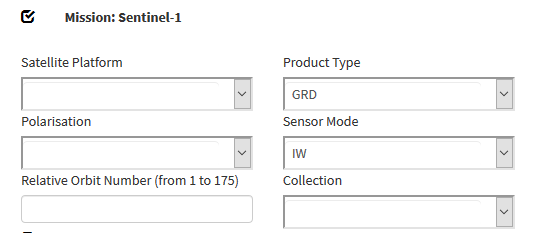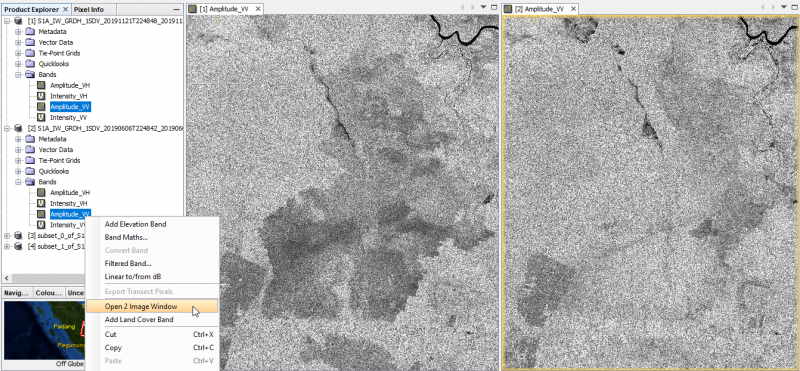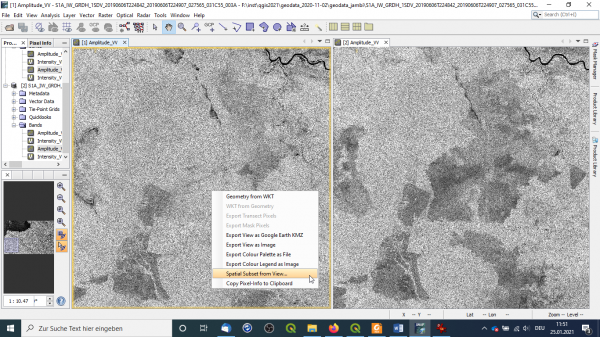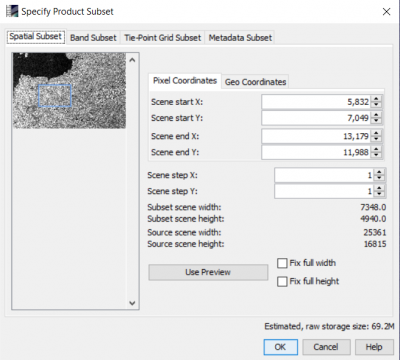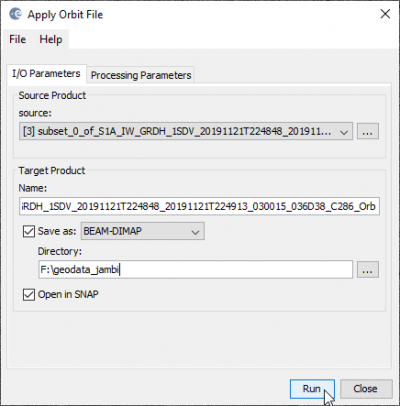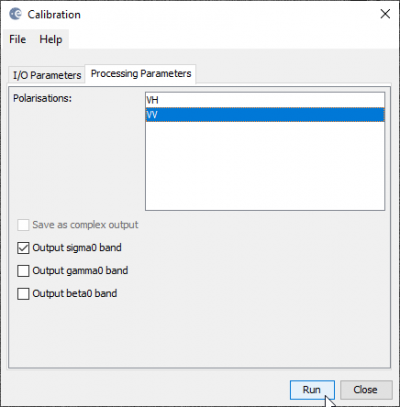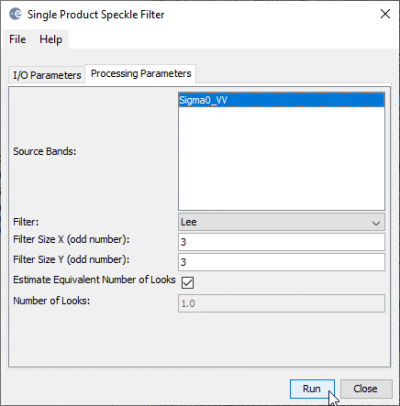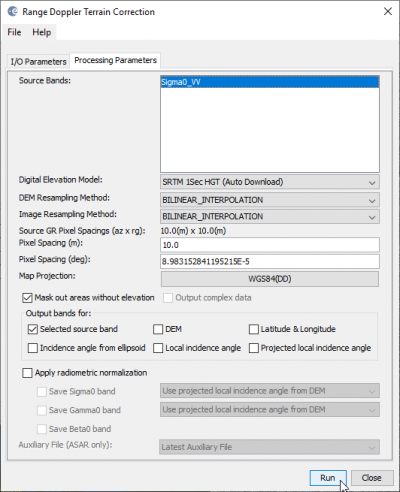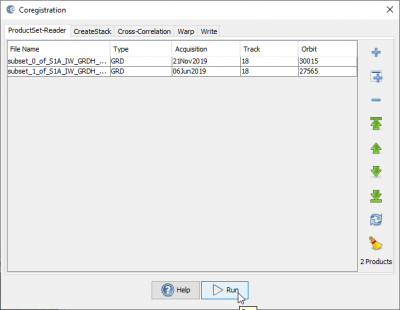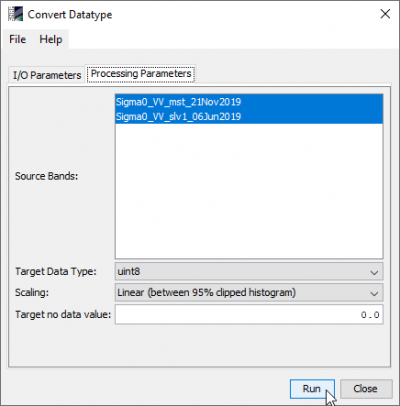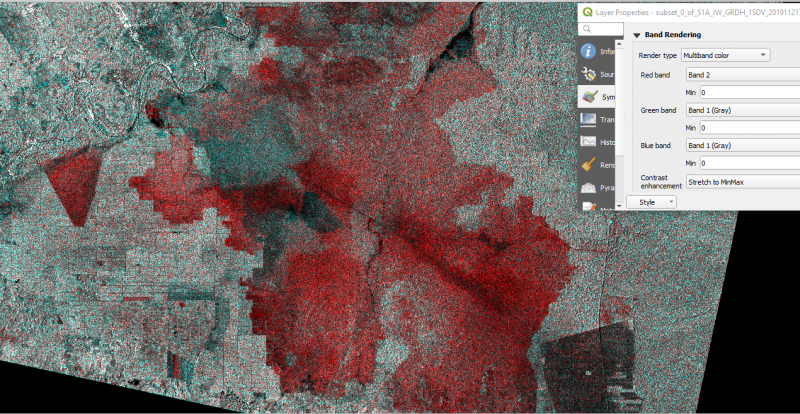SAR change detection with SNAP
(→UNDER CONSTRUCTION) |
(→Display in QGIS) |
||
| (52 intermediate revisions by 2 users not shown) | |||
| Line 1: | Line 1: | ||
| − | + | In this tutorial we will use Level-1 Ground Range Detected (GRD) Sentinel-1 data downloaded from the Copernicus Open Access Hub. The example are fire events during 2019 in a peat forest located in Eastern Jambi, Sumatra, Indonesia. | |
| − | + | ||
| − | + | ||
| − | + | ||
| − | In this tutorial we will use Level-1 Ground Range Detected (GRD) Sentinel-1 data downloaded from the Copernicus Open Access Hub. The example are fire events during | + | |
=Data transfer= | =Data transfer= | ||
| − | Download example | + | Download example data from STud.IP or use data from your personal region of interest: two Sentinel-1 scenes one pre-event acquisition date and one post-event date. Follow and adapt accordingly the instruction on [[Downloading Sentinel-2 images]]. |
Sentinel-1 data can have different characteristics (product type, polarization, sensor mode and ascending/descending orbit). Make sure, that you have the same characteristics for both images. | Sentinel-1 data can have different characteristics (product type, polarization, sensor mode and ascending/descending orbit). Make sure, that you have the same characteristics for both images. | ||
| − | Set the sensing period from 01.06.2019 to 30.11.2019. | + | Set the sensing period (e.g. from 01.06.2019 to 30.11.2019). |
Select Product type '''GRD''' and sensor mode '''IW'''. | Select Product type '''GRD''' and sensor mode '''IW'''. | ||
Download the images of the 06.06.2019 and 21.11.2019 (both GRD, VV/VH, IW, Descending). | Download the images of the 06.06.2019 and 21.11.2019 (both GRD, VV/VH, IW, Descending). | ||
[[File:esa_openhub_S1.png|600px]] | [[File:esa_openhub_S1.png|600px]] | ||
| + | |||
=Visualization of amplitude bands= | =Visualization of amplitude bands= | ||
* Open SNAP Desktop. | * Open SNAP Desktop. | ||
* Go to {{mitem|text=File → Import → SAR sensors → Sentinel-1}} and select the downloaded zip files. | * Go to {{mitem|text=File → Import → SAR sensors → Sentinel-1}} and select the downloaded zip files. | ||
| − | * | + | * In '''Product Explorer''' click on + to unfold the product folders. Mark the '''Amplitude_VV''' bands of both products. |
* Right click '''Open 2 Image Window'''. | * Right click '''Open 2 Image Window'''. | ||
| − | * {{mitem|text=Windows → Tile Horizontally}}. Both Amplitude bands are shown side by side geometrically linked to each other. | + | * {{mitem|text=Windows → Tile Horizontally}}. Both Amplitude bands are shown side by side geometrically linked to each other. Make sure the option {{mitem|text=View --> Synchronise Image View}} and {{mitem|text=View --> Synchronise Image Cursors}}is activated). |
| + | * Adjust the viewer size that they are evenly. | ||
| + | * Zoom to an area of interest where you may detect changes (see below). Compare the pre-event (2019-06-06) and post-event image (2019-11-21). | ||
[[File:snap_sidebyside.png|800px]] | [[File:snap_sidebyside.png|800px]] | ||
=Subsetting= | =Subsetting= | ||
| − | + | Subset the Sentinel-1 scenes reducing the data volume. | |
| − | * | + | * Activate the pre-event image clicking on the tab of the viewer. The active image is marked with a yellow frame. |
| − | + | ||
[[File:SNAP_Select_Subset_Area.PNG|600px]] | [[File:SNAP_Select_Subset_Area.PNG|600px]] | ||
| − | * | + | * Right click into the active image and select '''Spatial Subset from View...'''. |
| − | + | ||
| − | [[File:SNAP_Subset.PNG| | + | [[File:SNAP_Subset.PNG|400px]] |
| + | * Besides a spatial subset you can also select a band subset with this tool. Go to the tab {{button|text=Band subset}} and select only one band '''Amplitude_VV'''. | ||
| + | * Click {{button|text=OK}}. | ||
| + | * A new Product subset_* can be found in the Product Explorer. | ||
| + | + Activate the prost-event image and repeat the work steps above. | ||
| + | ''Note, the resulting images are still in acquisition geometry, whereby the images appear mirrored.'' | ||
| + | =Radiometric and geometric calibration= | ||
| + | === Apply Orbit File === | ||
| + | * Select the subset '''pre-event''' product from the previous step within the '''Product Explorer'''. | ||
| + | * Go to {{mitem|text=Radar → Apply Orbit File}} | ||
| + | * Default settings are fine. | ||
| + | * Select target product directory. | ||
| + | [[File:snap_apply_orbit.png|400px]] | ||
| + | * Click {{button|text=Run}}. | ||
| − | ''' | + | === Radiometric Calibration === |
| + | * Select the product from the previous step within the '''Product Explorer''' on the left side. | ||
| + | * Go to {{mitem|text=Radar → Radiometric → Calibrate}} | ||
| + | * Select target product directory. | ||
| + | * Go to the '''Processing Parameters''' tab and check sigma0. (You could also use gamma0 processing.) | ||
| + | [[File:snap_calibrate.png|400px]] | ||
| + | * Click {{button|text=Run}}. | ||
| + | === Single Product Speckle Filter === | ||
| + | * Select the product from the previous step within the '''Product Explorer''' on the left side. | ||
| + | * For speckle filtering, there are many different options of filter algorithms and window size. | ||
| + | * Use the Lee filter with a window size of 3x3. | ||
| + | * Go to {{mitem|text=Radar → Speckle Filtering → Single Product Speckle Filter}} | ||
| + | * Select target product directory. | ||
| + | * Go to the '''Processing Parameters''' tab and select '''Lee''' in the '''Filter''' drop down menue. | ||
| + | * Adapt the window size in X and Y direction accordingly. | ||
| + | [[File:snap_leefilter.png|400px]] | ||
| + | * Click {{button|text=Run}}. | ||
| − | = | + | === Range-Doppler-Terrain Correction === |
| − | * Select the | + | * Select the product from the previous step within the '''Product Explorer''' on the left side. |
| − | * | + | * Go to {{mitem|text=Radar → Geometric → Terrain Correction → Range-Doppler-Terrain Correction}} |
| − | * | + | * Select target product directory. |
| − | * | + | * Go to the '''Processing Parameters''' tab and select '''SRTM 1sec HGT (Auto Download)''' in the '''Digital Elevation Model''' drop down menue. |
| − | * | + | [[File:snap_terrain_correction.png|400px]] |
| − | * | + | * Click {{button|text=Run}}. |
| + | * Now the image should be correctly displayed, in terms of geometry, and be smoothed. | ||
| + | |||
| + | '''Repeat the radiometric and geometric calibration steps for the post-event subset (second acquisiton date)!''' | ||
=Change composite= | =Change composite= | ||
| − | * | + | === Create Stack === |
| − | [[File: | + | * Close all products by marking them all '''Product Explorer''' on the left side, right click and '''Close All Products'''. |
| − | * | + | * {{mitem|text=File --> Open Product}}. Load both radiometric and geometric corrected images from the previous step with the extension '''_Orb_Cal_Spk_TC.dim'''. |
| − | * {{button|text=Run}}. | + | * Go to {{mitem|text=Radar → Coregistration → Stack Tools → Create Stack}} |
| + | * Click on [[File:snap_add_open_button.png]] button on the right side to select the images. | ||
| + | * Leave the default settings at the '''2-CreateStack''' tab. | ||
| + | * Go to the '''3-Write''' tab and select target product directory. | ||
| + | [[File:snap_stack.png|400px]] | ||
| + | * Click {{button|text=Run}}. | ||
| + | |||
| + | === Convert Datatype === | ||
| + | * Select the product from the previous step within the '''Product Explorer''' on the left side. | ||
| + | * Go to {{mitem|text=Raster → Data Conversion → Convert datatype}} | ||
| + | * Save as {{button|text=GeoTIFF}}. | ||
| + | * Select target product directory. | ||
| + | [[File:snap_datatype2.png|400px]] | ||
| + | * Default settings are fine. | ||
| + | * Click {{button|text=Run}}. | ||
| + | |||
| + | === Display in QGIS === | ||
* Open QGIS. | * Open QGIS. | ||
* {{mitem|text=Data Source Manger --> Browser --> XYZ Tiles --> Google Satellite}} | * {{mitem|text=Data Source Manger --> Browser --> XYZ Tiles --> Google Satellite}} | ||
| − | * Load the change compoisite file with extension ''' | + | * Load the change compoisite file with extension '''_Cnv.tif''' {{mitem|text=Data Source Manger --> Raster}}. |
| + | * {{mitem|text=Layer properties --> Symbology}}. Adjust the band assignment: Red = Band 2, Green = Band 1, Blue = Band 1. | ||
* Adjust opacity of the change layer on top of Google Satellite. {{mitem|text=Layer Properties --> Transparency --> Global Transparency}}. | * Adjust opacity of the change layer on top of Google Satellite. {{mitem|text=Layer Properties --> Transparency --> Global Transparency}}. | ||
| − | [[File: | + | In the bi-temporal change composite red indicates change areas. |
| + | |||
| + | [[File:snap_change_composite2.png|800px]] | ||
[[Category:SNAP Tutorial]] | [[Category:SNAP Tutorial]] | ||
[[Category:Tutorials]] | [[Category:Tutorials]] | ||
Latest revision as of 13:16, 25 January 2021
In this tutorial we will use Level-1 Ground Range Detected (GRD) Sentinel-1 data downloaded from the Copernicus Open Access Hub. The example are fire events during 2019 in a peat forest located in Eastern Jambi, Sumatra, Indonesia.
Contents |
[edit] Data transfer
Download example data from STud.IP or use data from your personal region of interest: two Sentinel-1 scenes one pre-event acquisition date and one post-event date. Follow and adapt accordingly the instruction on Downloading Sentinel-2 images. Sentinel-1 data can have different characteristics (product type, polarization, sensor mode and ascending/descending orbit). Make sure, that you have the same characteristics for both images. Set the sensing period (e.g. from 01.06.2019 to 30.11.2019). Select Product type GRD and sensor mode IW. Download the images of the 06.06.2019 and 21.11.2019 (both GRD, VV/VH, IW, Descending).
[edit] Visualization of amplitude bands
- Open SNAP Desktop.
- Go to File → Import → SAR sensors → Sentinel-1 and select the downloaded zip files.
- In Product Explorer click on + to unfold the product folders. Mark the Amplitude_VV bands of both products.
- Right click Open 2 Image Window.
- Windows → Tile Horizontally. Both Amplitude bands are shown side by side geometrically linked to each other. Make sure the option View --> Synchronise Image View and View --> Synchronise Image Cursorsis activated).
- Adjust the viewer size that they are evenly.
- Zoom to an area of interest where you may detect changes (see below). Compare the pre-event (2019-06-06) and post-event image (2019-11-21).
[edit] Subsetting
Subset the Sentinel-1 scenes reducing the data volume.
- Activate the pre-event image clicking on the tab of the viewer. The active image is marked with a yellow frame.
- Right click into the active image and select Spatial Subset from View....
- Besides a spatial subset you can also select a band subset with this tool. Go to the tab Band subset and select only one band Amplitude_VV.
- Click OK.
- A new Product subset_* can be found in the Product Explorer.
+ Activate the prost-event image and repeat the work steps above. Note, the resulting images are still in acquisition geometry, whereby the images appear mirrored.
[edit] Radiometric and geometric calibration
[edit] Apply Orbit File
- Select the subset pre-event product from the previous step within the Product Explorer.
- Go to Radar → Apply Orbit File
- Default settings are fine.
- Select target product directory.
- Click Run.
[edit] Radiometric Calibration
- Select the product from the previous step within the Product Explorer on the left side.
- Go to Radar → Radiometric → Calibrate
- Select target product directory.
- Go to the Processing Parameters tab and check sigma0. (You could also use gamma0 processing.)
- Click Run.
[edit] Single Product Speckle Filter
- Select the product from the previous step within the Product Explorer on the left side.
- For speckle filtering, there are many different options of filter algorithms and window size.
- Use the Lee filter with a window size of 3x3.
- Go to Radar → Speckle Filtering → Single Product Speckle Filter
- Select target product directory.
- Go to the Processing Parameters tab and select Lee in the Filter drop down menue.
- Adapt the window size in X and Y direction accordingly.
- Click Run.
[edit] Range-Doppler-Terrain Correction
- Select the product from the previous step within the Product Explorer on the left side.
- Go to Radar → Geometric → Terrain Correction → Range-Doppler-Terrain Correction
- Select target product directory.
- Go to the Processing Parameters tab and select SRTM 1sec HGT (Auto Download) in the Digital Elevation Model drop down menue.
- Click Run.
- Now the image should be correctly displayed, in terms of geometry, and be smoothed.
Repeat the radiometric and geometric calibration steps for the post-event subset (second acquisiton date)!
[edit] Change composite
[edit] Create Stack
- Close all products by marking them all Product Explorer on the left side, right click and Close All Products.
- File --> Open Product. Load both radiometric and geometric corrected images from the previous step with the extension _Orb_Cal_Spk_TC.dim.
- Go to Radar → Coregistration → Stack Tools → Create Stack
- Click on
 button on the right side to select the images.
button on the right side to select the images.
- Leave the default settings at the 2-CreateStack tab.
- Go to the 3-Write tab and select target product directory.
- Click Run.
[edit] Convert Datatype
- Select the product from the previous step within the Product Explorer on the left side.
- Go to Raster → Data Conversion → Convert datatype
- Save as GeoTIFF.
- Select target product directory.
- Default settings are fine.
- Click Run.
[edit] Display in QGIS
- Open QGIS.
- Data Source Manger --> Browser --> XYZ Tiles --> Google Satellite
- Load the change compoisite file with extension _Cnv.tif Data Source Manger --> Raster.
- Layer properties --> Symbology. Adjust the band assignment: Red = Band 2, Green = Band 1, Blue = Band 1.
- Adjust opacity of the change layer on top of Google Satellite. Layer Properties --> Transparency --> Global Transparency.
In the bi-temporal change composite red indicates change areas.
